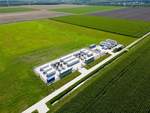Engineers develop cybersecurity tools to protect solar, wind power on the grid
They have sensors, controllers, actuators or inverters that are directly or indirectly connected to the internet. They’re distributed far and wide across the country and the countryside. Many have insecure connectivity to legacy electric grid systems. They have complex physics. They’re subject to advanced persistent threats. And there will be more and more of them going online.
So there’s a need for cybersecurity systems that “prevent, detect and mitigate” attacks on renewable sources sending power to the grid, said Gelli Ravikumar, a research assistant professor of electrical and computer engineering at Iowa State University.
Gelli is leading a team that’s developing those systems as part of a $12 million, six-project effort by the U.S. Department of Energy.
“Investing in cutting-edge cybersecurity technology keeps us at the forefront of global innovation and protects America’s power grid in the face of increasing cyberthreats from abroad,” said Jennifer Granholm, the U.S. secretary of energy, when the grants were announced this spring.
Cybersecurity through artificial intelligence
The energy department is supporting the Iowa State-led project with a three-year, $2 million grant. The researchers call their effort “GridDeep” and will research, develop and demonstrate a physics-based system that uses artificial intelligence tools to improve the cybersecurity of the country’s energy delivery systems.
“The project’s next-generation, AI-integrated cyber-physical security technology and tools can aid in ensuring energy delivery systems are designed, installed, operated and maintained to quickly recover from cyberattacks,” Gelli said.
Because those energy delivery systems are complex and constantly changing, Gelli said artificial intelligence technology will help electricity producers better understand their systems, quickly respond to attacks and restore critical functions.
Partners building innovative solutions
The project is especially timely because “a lot of green energy is being integrated into the grid,” said Manimaran Govindarasu, an Iowa State Anson Marston Distinguished Professor in Engineering, the Murray J. and Ruth M. Harpole Professor in Electrical and Computer Engineering and a co-leader of the research team. “We want to ensure the security and resilience of this renewable integration.”
A major challenge is that these renewable power sources operate more like smaller municipal or co-op power plants, Govindarasu said. There are limited resources for protecting them and more opportunities for attacking them.
“We need innovative solutions,” he said. “And we need the potential to scale up.”
The Iowa State engineers said it will take a group effort to secure the growing number of renewable power sources – and so the project includes researchers from Iowa State, the University of Texas at El Paso, the Electric Power Research Institute, Duke Energy, Alliant Energy, Google, OSIsoft and Schweitzer Engineering Laboratories.
“We’re bringing together IT companies, energy-system vendors and utility companies,” Govindarasu said. “This will be an opportunity to leverage their expertise and advance this technology. There will be quite a bit of synergy, collaboration and innovation.”
And that, Gelli said, will lead to “cyber-physical security tools and technologies that are not yet available today but can become widely adopted throughout the energy sector to reduce the risk that a cyber incident could disrupt energy delivery systems.”
- Source:
- Iowa State University
- Author:
- Press Office
- Link:
- www.news.iastate.edu/...
- Keywords:
- Iowa State University, data, security, cyber attack, grid, wind, solar, cybersecurity, USA, development, internet, research, technology, AI

























